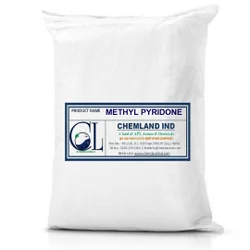Methylpyridine
- CAS NO.:1333-41-1
- Empirical Formula: C5H10O3
- Molecular Weight: 118.13
- MDL number: MFCD09751413
- EINECS: 215-588-6
- SAFETY DATA SHEET (SDS)
- Update Date: 2024-12-18 14:07:02

What is Methylpyridine?
Chemical properties
Picolines are colorless liquids. Strong, unpleasant, pyridine-like odor.“Picoline” is often used as mixed isomers.
Definition
ChEBI: 2-methylpyridine is a methylpyridine carrying a methyl substituent at position 2.
General Description
Clear colorless liquids with a strong unpleasant odor. Flash point 79 - 97°F. Less dense than water. Vapors heavier than air. Toxic oxides of nitrogen produced during the combustion of. Used as a solvent and to make other chemicals.
Air & Water Reactions
Highly flammable. Soluble in water.
Reactivity Profile
GAMMA PICOLINE or 4-METHYLPYRIDINE neutralizes acids in exothermic reactions to form salts plus water. Methyl propyl carbonate is incompatible with isocyanates, halogenated organics, peroxides, phenols, sulfuric acid, epoxides, anhydrides, acid halides and Iron (II) sulfate. Gamma picoline may generate hydrogen, a flammable gas, in combination with strong reducing agents such as hydrides. Dangerous fire hazard when exposed to heat, flame or oxidizers. Severe explosion hazards in the form of vapor, when exposed to flame or spark. Reacts violently with chlorosulfonic acid; CrO3; maleic anhydride; HNO3; oleum; perchromates; B-propiolactone; AgClO4; H2SO4;formamide; SO3; I. Dangerous when heated to decomposition Methyl propyl carbonate emits highly toxic fumes of cyanides; can react vigorously with oxidizing materials.
Health Hazard
Harmful if swallowed, inhaled or absorbed through the skin. Causes severe irritation. High concentrations are extremely destructive to tissues of the mucous membranes and upper respiratory tract, eyes and skin. Symptoms of exposure may include burning sensation, coughing, wheezing, laryngitis, shortness of breath, headache, nausea, vomiting and gastrointestinal disturbances.
Fire Hazard
Special Hazards of Combustion Products: Emits toxic fumes under fire conditions. Forms explosive mixture in air.
Potential Exposure
(o-isomer); Suspected reprotoxic hazard, Primary irritant (w/o allergic reaction), (m-isomer): Possible risk of forming tumors, Primary irritant (w/o allergic reaction). Picolines are used as intermediates in pharmaceutical manufacture, pesticide manufacture; and in the manufacture of dyes and rubber chemicals. It is also used as a solvent.
Shipping
UN2313 Picolines, Hazard Class: 3; Labels: 3-Flammable liquid.
Incompatibilities
Vapors may form explosive mixture with air. Incompatible with oxidizers (chlorates, nitrates, peroxides, permanganates, perchlorates, chlorine, bromine, fluorine, etc.); contact may cause fires or explosions. Keep away from alkaline materials, strong bases, strong acids, oxoacids, epoxides. Attacks copper and its alloys.
Properties of Methylpyridine
| Melting point: | 2.4°C |
| Boiling point: | 128.58°C (estimate) |
| Density | 0.9490 (estimate) |
| refractive index | 1.5019 (estimate) |
| CAS DataBase Reference | 1333-41-1(CAS DataBase Reference) |
| EPA Substance Registry System | Methylpyridine (1333-41-1) |
Safety information for Methylpyridine
Computed Descriptors for Methylpyridine
Methylpyridine manufacturer
New Products
4,4-Difluoropiperidine hydrochloride tert-butyl 9-methoxy-3-azaspiro[5.5]undecane-3-carboxylate Indole Methyl Resin N-Isopropylurea N,N-Dicyclohexylcarbodiimide(DCC) MELDRUMS ACID 5-METHYLISOXAZOLE-4-CARBOXYLIC ACID Magnessium Bis glycinate Zinc ascorbate 1-bromo-2-butyne 2-acetamidophenol 9(10H)-anthracenone Erythrosin B, 4-Piperidinopiperidine 2-((4-morpholinophenylamino) (methylthio) methylene) malononitrile 2,4-dihydroxybenzaldehyde 3-(4-morpholinophenylamino)-5-amino-1H-pyrazole-4-carbonitrile Methyl 2-methylquinoline-6-carboxylate 2,6-dichloro-4-nitropyridine 4-Bromo-2-chlorobenzonitrile 2-(benzylamino)acetic acid hydrochloride 4-(tert-Butoxycarbonylamino)but- 2-ynoic acid 3,4-dihydro-2H-benzo[b][1,4]dioxepine 1-Phenyl-1-cycloprppanecarboxylicacidRelated products of tetrahydrofuran








You may like
-
 Methyl Pyridine powder, 25kgView Details
Methyl Pyridine powder, 25kgView Details
1333-41-1 -
 3-(4-amino-1-oxoisoindolin-2-yl)-1-methylpiperidine-2,6-dione 98%View Details
3-(4-amino-1-oxoisoindolin-2-yl)-1-methylpiperidine-2,6-dione 98%View Details -
 614-19-7 98%View Details
614-19-7 98%View Details
614-19-7 -
 3112-85-4 Methyl phenyl sulfone 98%View Details
3112-85-4 Methyl phenyl sulfone 98%View Details
3112-85-4 -
 20677-73-0 (2,2-diethoxyethyl)methylamine 98%View Details
20677-73-0 (2,2-diethoxyethyl)methylamine 98%View Details
20677-73-0 -
 3-(4-(hydroxyamino)-1-oxoisoindolin-2-yl)piperidine-2,6-dione 98%View Details
3-(4-(hydroxyamino)-1-oxoisoindolin-2-yl)piperidine-2,6-dione 98%View Details -
 57381-49-4 2-bromo-4-chlorobenzonitrile 98%View Details
57381-49-4 2-bromo-4-chlorobenzonitrile 98%View Details
57381-49-4 -
 4,6-dichloropyrimidine-5-carbaldehyde 98%View Details
4,6-dichloropyrimidine-5-carbaldehyde 98%View Details
5305-40-8
